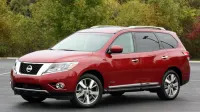2014 Nissan Pathfinder Hybrid

For 2014, Nissan has added a new hybrid option for its Pathfinder, using an all-new powertrain that will also be shared with the CUV’s Infiniti-badged QX60 sibling. As far as fuel economy is concerned, our long-term Pathfinder has had no problem hitting its EPA-estimated numbers of 19 miles per gallon city and 25 mpg highway, but this new hybrid model is said to be good for an increase in overall economy – 25/28 mpg (city/highway) when equipped with front-wheel drive and 25/27 mpg with optional four-wheel drive.
We recently took the 2014 Pathfinder Hybrid for a quick spin around the city streets of Nashville, TN. And while our time with the non-hybrid Pathfinder has been pretty enjoyable overall, at first blush, we’re having a tougher time warming up to this electrified variant.
Driving Notes
- The 2014 Pathfinder Hybrid is powered by a supercharged, 2.5-liter inline four-cylinder engine which, on its own, is good for 230 horsepower and 243 pound-feet of torque. Nissan has coupled that four-pot with a 15-kilowatt electric motor, which brings overall system output up to 250 hp and 243 lb-ft – a decrease of 10 hp versus the non-hybrid model, but a gain of 3 lb-ft.
- Nissan once again employs its well-behaved continuously variable transmission here in the Pathfinder Hybrid, and really, it’s fine. Nothing to write home about, for sure, but CVTs (well, e-CVTs in most hybrids) have long been the tranny of choice for hybrid applications, and when it comes to continuously variable units, Nissan does them better than most.
- Compared to the standard Pathfinder, this hybrid model is 228 pounds heavier (comparing Platinum trim levels). Yet you don’t really feel the added heft on the road. For starters, the Hybrid’s 243 lb-ft of torque comes on at 3,600 rpm versus the non-hybrid’s 240 lb-ft at 4,400 rpm, and the wee bit of electric assist at takeoff means this heavier model still gets up and goes just as quickly as it ever did. No official 0-60 numbers are available for either model, but we’re willing to bet the two are awfully close – if there is a difference, it’s not really noticeable from behind the wheel in city driving.
- That said, the hybrid system isn’t nearly as smooth as we’d like, especially off the line. The throttle feels dead at initial tip-in, and you really have to dig into the rightmost pedal to get the Pathfinder Hybrid to move. Once it’s in motion, the gasoline engine kicks in with an uncultivated action and coarse sound.
- There’s a similar sort of displeasure when its time to bring things to a halt. Just the opposite from the vague throttle response, the brakes are particularly grabby right from the get-go, presumably because the system is programed to eke out as much regenerative braking energy as it can. Sure, you get used to it, but we’d certainly like a brake pedal that’s easier to modulate with a more linear feel. All-in, the Pathfinder Hybrid just isn’t as smooth and easy to drive as its non-hybrid sibling.
- As far as real-world economy goes, we didn’t have a chance to get seriously accurate numbers, given the extreme brevity of our test drive (15 miles through the city). That said, we’ve not yet had any real discrepancies with Nissan’s official mileage numbers, and 26 mpg combined doesn’t seem too far-fetched for this hybridized Pathfinder.
- Aside from the powerplant, Nissan hasn’t made any other changes to the Pathfinder in creating this hybrid model, save a set of redesigned, full-LED taillamps that are exclusive to the electrified variant, as well as the obvious exterior badging.
- The same can be said for the interior, where everything has been left alone. No complaints here, as our time with the long-term 2013 Pathfinder can attest to. And unlike other hybrid vehicles, Nissan has managed to package the battery system in a way that it doesn’t impede interior functionality – the Pathfinder Hybrid’s cabin is just as capacious as the standard model.
- Nissan will offer the Pathfinder Hybrid in SV, SL, SL Premium, Platinum and Platinum Premium trims, starting at a base price of $35,110 (not including $860 for destination) – a $3,000 up-charge from the non-hybrid version. A fully loaded Platinum Premium 4WD will set you back $47,510..
- From where we sit, that’s quite a price premium considering what the Pathfinder Hybrid offers. Despite offering a combined fuel economy rating that’s 4 mpg better than the gas-only model, it doesn’t offer anything additional in the way of creature comforts and amenities, it’s more complex, and frankly, it’s not as nice to drive. Of course, we need more time behind the wheel to see what sort of real-world numbers this hybrid system can achieve, but for the moment at least, we aren’t sold.
- That’s a shame, too. We like the Pathfinder a whole lot, but unless Nissan can smooth out its gasoline-electric powertrain, we just don’t see any reason to pony up the dough for the Hybrid.




